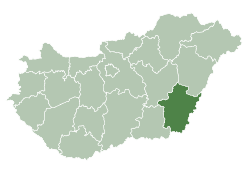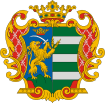Békéscsaba
Békéscsaba (Hungarian pronunciation: [ˈbeːkeːʃt͡ʃɒbɒ]; see also other alternative names) is a city in Southeast Hungary, the capital of the county Békés.
Békéscsaba Békešská Čaba (in Slovak) Bichișciaba (in Romanian) | |
|---|---|
City with county rights | |
| Békéscsaba Megyei Jogú Város | |
Békéscsaba city hall | |
 Flag 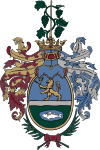 Coat of arms | |
Békéscsaba 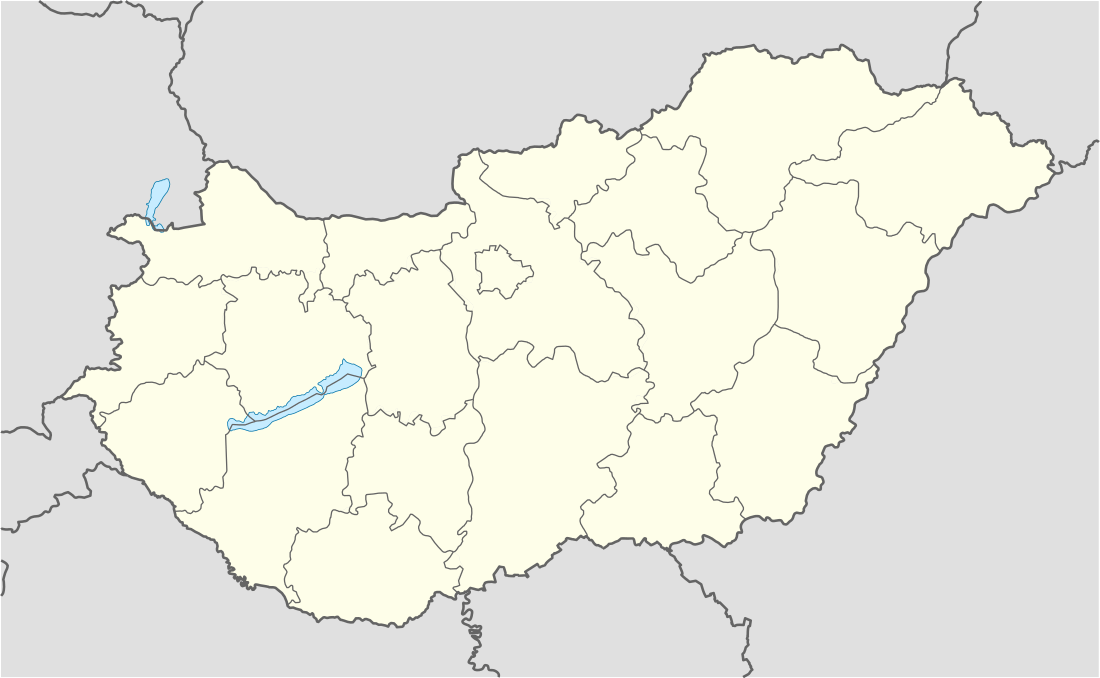 Békéscsaba  Békéscsaba | |
| Coordinates: 46.679°N 21.091°E | |
| Country | |
| County | Békés |
| District | Békéscsaba |
| Government | |
| • Mayor | Péter Szarvas (Independent) |
| Area | |
| • Total | 193.93 km2 (74.88 sq mi) |
| Elevation | 89 m (292 ft) |
| Population (2017) | |
| • Total | 59,732[1] |
| • Rank | 16th in Hungary |
| Time zone | UTC+1 (CET) |
| • Summer (DST) | UTC+2 (CEST) |
| Postal code | 5600, 5623, 5671 |
| Area code | (+36) 66 |
| Website | www |
Geography
Békéscsaba is located in the Great Hungarian Plain, 215 km (134 mi) southeast from Budapest. Highway 44, 47, Békéscsaba beltway (around the city) and Budapest-Szolnok-Békéscsaba-Lökösháza high speed (120–160 km/h (75–99 mph)) railway line also cross the city. Highway 44 is a four-lane expressway between Békéscsaba and Gyula.[2] According to the 2011 census, the city has a total area of 193.93 km2 (75 sq mi).
Name
Csaba is popular Hungarian given name for boys, of Turkic origin, while prefix Békés refers to the county name Békés, which means peaceful in Hungarian. Other names derived from the Hungarian one (German: Tschabe, Romanian: Bichișciaba, Slovak: Békešská Čaba).
History
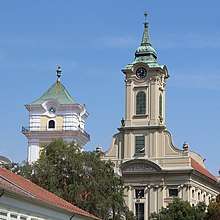
The area has been inhabited since the ancient times. In the Iron Age the area had been conquered by the Scythians, by the Celts, then by the Huns. After the Hungarian Conquest, there were many small villages in the area.
The medieval Hungarian village of Csaba was established in the 13th century,[3] first mentioned in the 1330s. Besides Csaba, eight other villages stood where now the town stands. According to the Hungarian Royal Treasury, Békéscsaba was an ethnic Hungarian settlement in 1495.[4] When the Turks conquered the southern and central parts of Hungary, and these territories became part of the Ottoman Empire, the town survived, but it became extinct[3] during the fights against the Turks in the 17th century.
In 1715, Csaba is mentioned as a deserted place, but only one year later its name can be found in a document mentioning the tax-paying towns. It is likely that the new Csaba was founded by János György Harruckern, who earned distinction in the liberation fights against the Ottoman Empire and bought the area of Békés county. In 1718, Harruckern invited Slovak settlers from Upper Hungary to the deserted area.[3] By 1847, the town was among the twenty largest towns of Hungary, with a population of 22,000. Nevertheless, Csaba was still like a large village, with muddy streets and crowded houses.
By 1858, the railway line reached the town. This brought development; new houses and factories were built, the town began to prosper. Still, by the end of the 19th century the unemployment caused great tension, and in 1891 a revolt was oppressed by the help of Romanian soldiers. One of the most important person in the politics of the town was András L. Áchim, who founded a peasants' party and succeeded in having Békéscsaba elevated to the rank of "city with council".
World War I brought suffering to the town. Between 1919 and 1920, Békéscsaba was under Romanian occupation. After the Treaty of Trianon, Hungary lost its most important Southern cities, Arad and Nagyvárad (Oradea, both of them today in Romania), and Békéscsaba had to take over their roles, becoming the most important town of the area. Hungarians overtook Slovaks in the 1920s, become the majority according to the census was held in 1930.[4]
Between the two world wars the recession caused poverty and unemployment, and a flood in 1925 did not help either.
Battles were not fought in the area during World War II. However, several events occurred in the town in 1944: between 24 and 26 June 1944, over 3,000 Jews were sent to Auschwitz.
On 21 September 1944, the British and American Air Force bombed the railway station and its surroundings, killing more than 100 people. On 6 October 1944, the Soviet army occupied Békéscsaba.
During the Socialist times, Békéscsaba became the county seat of Békés (1950) and began to develop into one of the most important centres of food industry of Hungary.[3] After the fall of the Communism in 1989, the industry nearly collapsed and many people lost their jobs. However, today the crisis seems to be over and Békéscsaba remained one of the most important centers of the Hungarian food industry.[5]
Demographics
| Historical population of Békéscsaba | |||||||||||||
| Year | Population | Hungarians | Slovaks | ||||||||||
|---|---|---|---|---|---|---|---|---|---|---|---|---|---|
| 1880 | 32,616 | 6,250 (19.2%) | 24,073 (73.8%) | ||||||||||
| 1890 | 34,243 | 7,728 (22.6%) | 25,917 (75.7%) | ||||||||||
| 1900 | 37,547 | 9,501 (25.3%) | 27,488 (73.2%) | ||||||||||
| 1910 | 42,599 | 13,271 (31.2%) | 28,682 (67.3%) | ||||||||||
| 1920 | 46,633 | 21,407 (45.9%) | 24,710 (53%) | ||||||||||
| 1930 | 49,374 | 30,054 (60.9%) | 18,931 (38.4%) | ||||||||||
| 1941 | 52,404 | 35,258 (67.3%) | 16,781 (32%) | ||||||||||
| 1949 | 45,892 | 44,328 (96.6%) | 1,254 (2.7%) | ||||||||||
| 1960 | 50,212 | 47,840 (95.3%) | 2,170 (4.3%) | ||||||||||
| 1980 | 67,225 | 66,388 (98.8%) | 679 (1%) | ||||||||||
| 2001 | 67,968 | 63,782 (93.8%) | 4,078 (6%) | ||||||||||
| 2011 | 62,050 | 51,842 (83.5%) | 1,881 (3%) | ||||||||||
Languages
According to the 2011 census the total population of Békéscsaba were 62,050, of whom 61,912 people (99.8%) speak Hungarian, 10,140 (16.3%) English, 4,821 (7.8%) German and 3,399 (5.5%) speak Slovak.[8]
Ethnic groups
According to the 2011 census there were 51,842 (83.5%) Hungarians, 1,881 (3%) Slovaks, 402 (0.6%) Roma, 293 (0.5%) Romanians and 170 (0.3%) Germans in Békéscsaba. 9,666 people (15.6%) did not declare their ethnicity.[8] In Hungary people can declare more than one ethnicity, so other people declared Hungarian and a minority one together.[9]
Religion
According to the 1869 census (first modern census in Hungary) Békéscsaba had 30,022 inhabitants, of whom there were 21,988 (73.2%) Lutheran, 5,880 (19.6%) Roman Catholic, 1,043 (3.5%) Jewish, 520 (1.7%) Orthodox and 436 (1.4%) Hungarian Reformed (Calvinist).[10]
The 1949 census showed 45,892 people, 25,661 (56.2%) Lutheran, 14,216 (31.1%) Roman Catholic, 4,750 (10.4%) Hungarian Reformed and 498 (1.1%) Jewish.[11]
In 2011 there were 10,694 (17.2%) Roman Catholic, 8,012 (12.9%) Lutheran and 4,408 (7.1%) Hungarian Reformed in Békéscsaba. 19,650 people (31.7%) were irreligious and 1,027 (1.7%) Atheist, while 16,883 people (27.2%) did not declare their religion.[8]
Tourist sights
- Great Lutheran Church (Evangélikus Nagytemplom)
- Small Lutheran Church (Evangélikus Kistemplom)
- Saint Anthony of Padua Cathedral (Páduai Szent Antal székesegyház)
- City hall (designed by Miklós Ybl, 1873) (Városháza)
- Mihály Munkácsy Museum (Munkácsy Mihály Múzeum)
- Mihály Munkácsy Memorial House (Munkácsy Mihály Emlékház)
- Mór Jókai Theatre (Jókai Színház)
- Slovak County House (Szlovák Tájház)
Politics
The current mayor of Békéscsaba is Péter Szarvas (Hajrá Békéscsaba).
The local Municipal Assembly, elected at the 2019 local government elections, is made up of 18 members (1 Mayor, 12 Individual constituencies MEPs and 5 Compensation List MEPs) divided into this political parties and alliances:[12]
| Party | Seats | Current Municipal Assembly | ||||||||
|---|---|---|---|---|---|---|---|---|---|---|
| Hajrá Békéscsaba | 8 | M | ||||||||
| Fidesz-KDNP | 7 | |||||||||
| MSZP-LMP | 2 | |||||||||
| DK-Jobbik-Dialogue | 1 | |||||||||
List of mayors
List of City Mayors from 1990:
| Member | Party | Term of office | |
|---|---|---|---|
| János Pap | SZDSZ | 1990–2006 | |
| Gyula Vantara | Fidesz-KDNP | 2016–2014 | |
| Péter Szarvas | Independent (Hajrá Békéscsaba) | 2014– | |
Notable people
Born in Békéscsaba
- András L. Áchim (1871-1911), Hungarian politician[3]
- Ján Valašťan Dolinský (1892–1965), Slovak composer
- Gyula Hegyi (1951), politician
- Károly Klimó (1936), artist
- Enikő Mihalik (1987), supermodel
- Henrietta Ónodi (1974), gymnast
- Béla Szabados (1974), swimmer
- Ádám Szepesi (1945), high jumper
- László Vidovszky (1944), composer and pianist
- Ágnes Késmárki (1981), singer and songwriter
- András Mengyán (1945), Fine artist, designer, professor
Lived in Békéscsaba
- Endre Bajcsy-Zsilinszky (1886-1944), Hungarian politician
- Mihály Munkácsy (1844-1900), Hungarian painter[3]
- Péter Kelemen World Champion Modern pentathlete
Died in Békéscsaba
- Sándor Erkel (1900), composer, son of Ferenc Erkel
International relations
Twin towns — Sister cities
Békéscsaba is twinned with:
References
- Békéscsaba, KSH
- Magyarország autóatlasz, Dimap-Szarvas, Budapest, 2004, ISBN 963-03-7576-1
- Antal Papp: Magyarország (Hungary), Panoráma, Budapest, 1982, ISBN 963 243 241 X, p. 860, pp. 449-453
- Károly Kocsis (DSc, University of Miskolc) – Zsolt Bottlik (PhD, Budapest University) – Patrik Tátrai: Etnikai térfolyamatok a Kárpát-medence határon túli régióiban, Magyar Tudományos Akadémia (Hungarian Academy of Sciences) – Földrajtudományi Kutatóintézet (Academy of Geographical Studies); Budapest; 2006.; ISBN 963-9545-10-4, CD Atlas
- Új élelmiszerüzem épül Békéscsabán (New food processing plant is going to build in Békéscsaba), Szabadföld, 05-04-2013 (Hungarian)
- 1880-1980 (census data): Magyarország történeti statisztikai helységnévtára, 3. Békés megye, KSH, Budapest, 1993, ISBN 963-215-003-1 - 2001 (census data): Hungarian census 2001, table 4.1.11 - 2011 (census data): Hungarian census 2011, 3.1.6.1
- In 2001 3,823 (5.6%), while in 2011 9,666 people (15.6%) opted out declaring ethnicity. In Hungary people can declare more than one ethnicity since 2001, so the sum of ethnicities is higher than the total population.
- 2011 Hungarian census, Békés county, tables 3.1.4.2, 3.1.6.1, 4.1.7.1
- Hungarian census 2011 - final data and methodology
- Az 1869. évi népszámlálás vallási adatai, KSH, Budapest, 2005, ISBN 963-218-661-3
- 1949. évi népszámlálás - vallási adatok településenként, KSH, Budapest, 1995, ISBN 963-215-082-1
- "Városi közgyűlés tagjai 2019-2024 - Békéscsaba (Békés megye)". valasztas.hu. Retrieved 2019-11-24.
- "Partner cities". Archived from the original on 6 August 2014. Retrieved 1 May 2014.
External links
| Wikimedia Commons has media related to Békéscsaba. |
| Wikivoyage has a travel guide for Békéscsaba. |
- Official website in Hungarian, English and German
- Photos of the town
- Aerial photography: Békéscsaba
